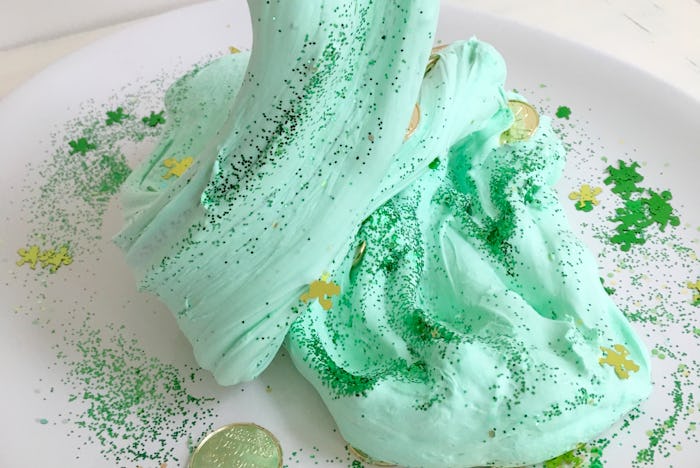Sometimes messy play is the best play. Kids can be very tactile and the feel of oozy slime can be awesome. Between making it and playing with it, it's the kind of thing that can keep little ones entertained. This is a wonderful craft project at any time of the year, and it's perfect for those winter afternoons when you are stuck inside. As St. Patrick's Day gets near, we all get a little obsessed with all things green, especially green and sparkly, so here's how to make St. Patrick's Day slime that will keep your kids occupied for hours.
There are many different recipes for making slime, often using ingredients you already have around the house. If you ever wondered why they sell Elmer's glue in giant containers (because how much gluing could one kindergartener do?), it's because everyone's making slime. The bloggers at Little Bins For Little Hands have put together a Fluffy St. Patrick's Day slime recipe, which uses shaving cream along with the more commonly used slime ingredients like glue, saline solution, baking soda, and food coloring. The first step is to mix the green food coloring into the shaving cream. After that, you can mix in the other ingredients and knead away. "This St Patricks Day fluffy slime is an amazing tactile sensory experience for kids of all ages who love to get their hands right into their play," Sarah McLelland of the Little Bins For Little Hands blog tells Romper. "Not to mention that making slime is also an excellent science demonstration. Hands on play and learning all in one extremely cool slime activity," she says.
Before you start your slime-making session, you need your supplies. Props to the mom who is a Type A project planner and is organized enough to order her supplies online, days ahead of time. But if this is more of an impromptu thing, you can head out to the craft store or even the supermarket to get what you need. In order to make the slime truly holiday-worthy, throw in some shamrock confetti ($4, Amazon) and green or gold glitter ($6, Michael's).
Why green? On St. Patrick's Day you can be blinded by all the green — shirts, socks, hats, silly headbands, bagels, milkshakes... it's everywhere. Some people think that anything Irish-related is frequently represented by the color green, particularly on St. Patrick's Day, as a tribute to how lush and green the landscape of Ireland is. But Time explained that it's origins are actually political: In the 1790's, there was a populist movement to bring "nonsectarian, republican ideas to Ireland." The main organizers of this, the Society of United Irishmen, were described in a police report as wearing a "dark green shirt cloth coat, green and white striped trousers, and a felt hat. Eventually, the uniform faded out of use, but the hat and the color green stuck.
But back to the slime. The nice thing about this project is that it's not only creative and tactile, but it as McLelland said, it sneaks in a science lesson. Slime contains polymers, which are long strands of molecules that are in rows. When these polymers are combined with other materials, they start to stick together, as explained on the MomDot blog. This is what makes it so stretchy and why, the more you knead it, the stretchier it gets. Sometimes the combination of ingredients isn't right or something else goes wrong and your slime is too sticky. This is when you need to troubleshoot your slime texture. Here's a list of helpful slime tips to try to rescue the batch.
Whatever you decide to add to your slime to make it festive for St. Patrick's Day, have fun with it. One word of caution though — stay away from doing it anywhere near your carpeting as slime in carpet is really hard to get out and could be a permanent St. Paddy's Day souvenir.
Check out Romper's new video series, Bearing The Motherload, where disagreeing parents from different sides of an issue sit down with a mediator and talk about how to support (and not judge) each other’s parenting perspectives. New episodes air Mondays on Facebook.
